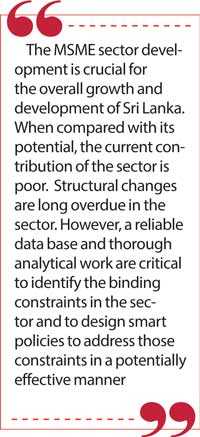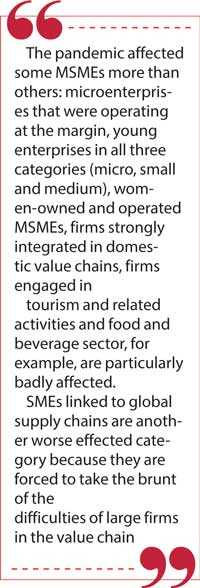Monday Dec 08, 2025
Monday Dec 08, 2025
Friday, 3 July 2020 00:00 - - {{hitsCtrl.values.hits}}


By Dr. Nimal A. Fernando
The COVID-19 pandemic has had a massive adverse impact on all type of enterprises across the globe, with the exception of few tech giants whose market capitalisation increased substantially as a result of the pandemic related factors. However, it is not surprising that the adverse effects on businesses have been uneven. The impact on micro, small and medium enterprises (MSMEs) has been disproportionate in particular. This holds true for the intra-sectoral impact as well.
Even before the COVID-19 pandemic hit the sector, governments in most countries have long-recognised that the MSME sector requires focused special policies and programs for its growth and sustainability. The pandemic made the case for such external support doubly stronger and more urgent.
The pandemic has crippled a massive number of MSMEs in virtually all developing nations and most of the developed nations. According to some analysts, it has “set in motion a downward spiral that can significantly impair the backbone of all economies”.
Uneven impact
The pandemic affected some MSMEs more than others: microenterprises that were operating at the margin, young enterprises in all three categories (micro, small and medium), women-owned and operated MSMEs, firms strongly integrated in domestic value chains, firms engaged in tourism and related activities and food and beverage sector, for example, are particularly badly affected. 
SMEs linked to global supply chains are another worse effected category because they are forced to take the brunt of the difficulties of large firms in the value chain.
The sector recovery is important for multiple reasons
Rapid and sustainable recovery of the pandemic affected MSME sector is critical for Sri Lanka for a multitude of reasons. First, data indicate that MSMEs account for over 50% of GDP. Hence their economic revival is important for regaining growth. Second, MSME sector account for over 45% of employment and an overwhelming proportion about 87% of the firms in the country.
ADB’s Asia SME Finance Monitor 2014 put the number of microenterprises in the country at 880, 066 and SMEs at 132,483. And the total employment in MSME sector was over 2.09 million, accounting for approximately 70% of the total employment in all type of firms. Thus sustaining employment levels in the enterprise sector and preventing a worsening of socio-economic inequality depend to a large extent on their revival.
Third, SMEs contribute to some 20% of the total export earnings of the country and their revival is important for foreign exchange earnings. Fourth, a vast majority of MSMEs are located outside the Western province and in the rural sector.
Therefore, they are important for regional economic development and reduction of regional socio-economic disparities and for rural development. Fifth, because of their sheer number, failure to resuscitate MSMEs is likely to contribute to social unrest and generate greater demand for more handouts from the government.
In terms of broader development objectives, the economic recovery of these firms essentially means preventing a vast number of people from falling into deeper poverty.
Pandemic damaged MSMEs through four channels
How the COVID-19 pandemic hit the MSME sector is an important issue when we discuss their economic revival. According to SME Finance Forum sponsored by the International Finance Corporation, the COVID-19 pandemic damaged MSMEs through four channels: falling demand; reduced input supplies; tightening of credit conditions and liquidity crunch; and rising uncertainty. Now that the recovery phase has begun across many countries, the severity of the effects of these seems to be declining though slowly in most cases and unevenly across and within countries.
The domestic demand for MSME products and services is beginning to improve from the pandemic affected levels. But a substantial pick-up in demand cannot be expected until the global economy improves and its spill-over effects are fully felt through multiple channels in the domestic economy.
Dismal economic growth projections
But the news is disturbing. According to the revised projections (24 June) of the IMF on global, regional and country-level growth and recovery, the global economy will shrink by 4.9% in 2020, much worse than the 3.0% shrink it projected in April.
The US economy will shrink by 8%, economies in the Eurozone by 10.2% and emerging markets and developing economies by 3.0%. The relative picture for Asia looks bit better: emerging and developing Asia economy will shrink but only by 0.8%.
The Chinese economy will grow but only by 1% while the economy of India will slide by 4.5%. When these numbers are put in the context of comparable pre-pandemic projections, they indicate a sharp decline in growth across the globe. Most economies will improve in 2021 but continue to lag behind the pre-pandemic levels.
The gloomy projections are suggestive of a near-certain adverse impact on the potential for recovery in the tourist sector – one of the worst affected sectors – in the rest of 2020 and also in the first half of 2021.
The negative growth during the rest of the year and low growth scenario for 2021 coupled with high unemployment levels that would prevail in 2021 across countries do not provide any ground to be  optimistic of the prospects of recovery of the MSMEs directly and indirectly linked to the tourist industry of Sri Lanka.
optimistic of the prospects of recovery of the MSMEs directly and indirectly linked to the tourist industry of Sri Lanka.
Similarly the MSMEs in wholesale and retail trade, accommodation and food services and personal services are likely to feel the economic brunt of the pandemic for a longer period even in the recovery phase despite numerous public support programs and targeted assistance.
Input supplies is likely to follow a similar pattern. MSMEs that depend on domestic sources for inputs are likely to overcome the bottleneck sooner than those that depend on overseas sources for their input supplies. Of the microenterprises, only about 25% were in manufacturing while 42% and 26% were in trade and services, respectively in 2013, according to Census and Statistics Department data.
If we assume that this distribution pattern reflects today’s reality as well, it tends to suggest that a substantial proportion of microenterprises are likely to partially recover within about six to nine months when other sectors begin to operate at pre-pandemic levels. However, the SMEs that depend on inputs from overseas will have to bear the pain of supply shortages and probably higher prices for a longer time.
Finance gap in the sector is huge
Many commentators seem to assume that the most critical factor for the recovery of the MSME sector will be the flow of credit.
This appears to be a valid observation because even before the pandemic fallout, the sector was beset with a problem of effective access to credit not only in Sri Lanka but also in other developing economies.
A joint study of the World Bank, IFC and SME Finance Forum, for example, estimated the formal sector MSME finance gap in developing and emerging market economies at $5.2 trillion in 2017. Microenterprises accounted for 14% (or $719 billion) of this total. SMEs accounted for 86% (or $4.5 trillion).
But all MSMEs are not credit constrained
However, the estimated colossal global (excluding rich countries) finance gap mask an interesting fact. That is not all MSMEs are financially constrained.
The same study estimated that in developing and emerging market economies 60% of the 141 million microenterprises and 56% of the 20.7 million SMEs are financially unconstrained while only 21% of the microenterprises and 30% of the SMEs are fully financially constrained. Partially financially constrained percentages were 19% for microenterprises and 14% for SMEs. Regionally, in South Asia 37% of the microenterprises were fully constrained while 16% were partially constrained leaving 47% in the unconstrained category. For SMEs, corresponding percentages were respectively 24% (fully constrained), 26% (partially constrained), and 50% (unconstrained), respectively. The total financing gap in South Asia was estimated at $337 billion: SMEs accounted for $290 billion (86%) and microenterprises accounted for $47 billion (14%) of this.
The estimated 4.48 million fully or partially credit constrained MSMEs in the region consisted of 3.91 million microenterprises (87%) and 570,000 SMEs (13%).
We must not overlook that the above numbers do not cover informal sector MSMEs. Although the study referred to earlier does not provide details on the informal sector, it puts the potential demand for finance in the global informal sector at $2.9 trillion.
Credit constraints are a frequently discussed subject in the country. But there is a serious lack of detailed data on the credit constraints of Sri Lanka’s MSMEs. However, based on the above global and regional data it may be reasonable to assume that a substantial proportion of MSMEs in Sri Lanka also may not be facing a credit constraint although lack of access to finance has been a constraint on the overall growth of the sector. Perhaps this explains in part the uneven growth that we can observe in the MSME sector in the country. It is possible that SMEs keen to upgrade their technology face serious credit constraints. Same may be true for those aiming at using more advanced agricultural and information and communication technology.
It is also possible that many MSMEs in the country are not using the liquidity at their command in the best possible manner to increase productivity.
The generally low productivity level in the MSME sector and the questionable quality of most of the products and services coming out of the MSME sector tend to support this observation.
A recent Daily FT article put the SME sector’s critical issues in perspective: “Solving the access to finance problem, debt moratoria, and low-interest rates may give them some breathing space for now, but the deeper and more fundamental issues need to be addressed to foster a resilient and thriving SME sector in Sri Lanka” (http://www.ft.lk/columns/Sri-Lankan-SMEs-need-some-introspection/4-702094). This observation is equally valid for the entire MSME sector.
Conclusion
The MSME sector development is crucial for the overall growth and development of Sri Lanka. When compared with its potential, the current contribution of the sector is poor. Structural changes are long overdue in the sector.
However, a reliable data base and thorough analytical work are critical to identify the binding constraints in the sector and to design smart policies to address those constraints in a potentially effective manner.
We do not need just evidence-based policies for the sector; we need reliable-evidence-based policies to transform the low-productivity MSME sector characterised by short-termism and lacklustre growth into a dynamic sector that can contribute to the growth and development of the country on a sustainable basis in line with the requirements of the 21st century.
(The writer is a development economist with over 40 years’ experience in the field. He is former Associate of the Kuala Lumpur-based Alliance for Financial Inclusion and former Practice Leader for Microfinance at the Asian Development Bank. He can be reached at [email protected]).